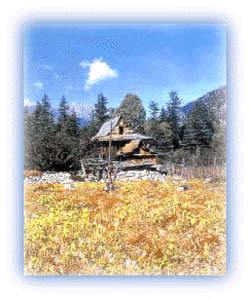Kinnaur himalayas
General
Info
· The
Satluj Saga
· The
Story of the Baspa
· Valleys
·
Hangrang valley
·
Ropa valley
·
Bhaba valley
· Other
places of interest
·
Nilchar
·
Kalpa and Peo
·
Pooh
·
Moorang
People
· Kinners
·
Traditions and Culture
·
Livelihood
· Villages
in Kinnaur

![]()
| Climate By virtue of its elevation, Kinnaur enjoys a temperate climate with long winters stretching from October to May and short summers extending from June to September. Only the lower parts of the Satluj Valley and the Baspa Valley receive monsoon rains while the upper areas of the valleys fall mainly under the rain shadow area. These parts have a dry Tibetan type of climate and are arid regions. |
Peo
Peo is the headquarters of Kinnaur. It has a better climate
than most other places in the region as it is situated in the
transition
 |
| Play of colors. Credit: Discover India |
Moorang
Moorang, in Kinnaur District, is situated near the banks of the
Satluj River in the arid tract. However, due to its location at
the bottom of the valley, conditions are relatively warmer. The
average temperature in July and August ranges from 20 to 23 C.
In October the mercury drops down to about 10 C.
Vegetation
Usually, the mountains in the lower parts of Kinnaur are well
covered with a thick blanket of forests. Although some of the
other parts of Kinnaur have gentler slopes, they do not have
the forests and rich pastures characteristic of this region,
owing mainly to the dry climate. Upper Kinnaur is an arid Trans
Himalayan region only sparsely covered with vegetation.
All rights reserved